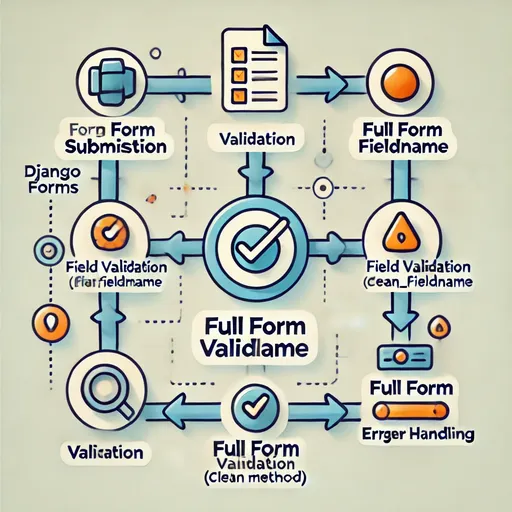One of the powerful features of Django Forms is validation. It automatically verifies the data entered by users before sending it to the server, ensuring safety and accuracy. In this post, we will explore the validation mechanism of Django Forms and how to customize it.
1. Basic Validation

1.1 What is Validation?
Django Forms checks whether the data meets the requirements of the form fields. This process consists of the basic validation provided by the form and custom validations defined by the developer.
Example of Basic Validation
from django import forms
class RegistrationForm(forms.Form):
username = forms.CharField(max_length=30, required=True)
email = forms.EmailField(required=True)
password = forms.CharField(widget=forms.PasswordInput, required=True)
username: Maximum length of 30 characters.email: Validates if it's in email format.password: Required input, utilizing a password input field.
1.2 Data Validation Flow
Django Forms stores validated data in cleaned_data, which is returned in the form of a dictionary with field names as keys.
- If data validation fails, error messages are stored in the
form.errorsattribute as a dictionary. Each field name acts as a key, and the corresponding error message as its value.
- The user inputs data and submits the form.
- Django calls the
is_valid()method to validate the data. - If data is valid, it is stored in
cleaned_data; otherwise, error messages are added.
Example of Data Validation Flow
form = RegistrationForm(request.POST)
if form.is_valid():
username = form.cleaned_data['username']
email = form.cleaned_data['email']
password = form.cleaned_data['password']
else:
print(form.errors) # Prints error on validation failure
2. Customizing Field Validation
2.1 clean_fieldname() Method
To customize the validation of a specific field, define the clean_fieldname() method.
Example: Duplicate Username Check
class RegistrationForm(forms.Form):
username = forms.CharField(max_length=30)
def clean_username(self):
username = self.cleaned_data['username']
if username.lower() == 'admin':
raise forms.ValidationError("'admin' cannot be used as a username.")
return username
How it works: The clean_username() method checks the validity of the username field and raises an exception if there's a problem.
3. Overall Form Validation
3.1 clean() Method
When validation based on the entire form data is needed, override the clean() method.
Example: Password Confirmation
class PasswordChangeForm(forms.Form):
new_password = forms.CharField(widget=forms.PasswordInput)
confirm_password = forms.CharField(widget=forms.PasswordInput)
def clean(self):
cleaned_data = super().clean()
password = cleaned_data.get("new_password")
confirm_password = cleaned_data.get("confirm_password")
if password != confirm_password:
raise forms.ValidationError("Passwords do not match.")
return cleaned_data
Purpose: Used when mutual validation between multiple fields is necessary.
4. Customizing Error Messages
Django Forms provides default error messages. However, you can customize them for a more user-friendly experience.
4.1 Modifying Field Error Messages
Example: Specifying Error Messages for Fields
class CustomErrorForm(forms.Form):
email = forms.EmailField(
error_messages={
'required': "Please enter your email.",
'invalid': "Please enter a valid email address."
}
)
4.2 Handling Overall Form Errors
Example: Password Validation Error Message
class LoginForm(forms.Form):
username = forms.CharField(max_length=30)
password = forms.CharField(widget=forms.PasswordInput)
def clean(self):
cleaned_data = super().clean()
username = cleaned_data.get('username')
password = cleaned_data.get('password')
# Add user authentication logic
if not authenticate(username=username, password=password):
raise forms.ValidationError("Username or password is incorrect.")
5. Real-World Example: Complex Validation
5.1 Implementing a Signup Form
Defining the Form
class SignupForm(forms.Form):
username = forms.CharField(max_length=30)
email = forms.EmailField()
password = forms.CharField(widget=forms.PasswordInput)
confirm_password = forms.CharField(widget=forms.PasswordInput)
def clean_username(self):
username = self.cleaned_data['username']
if User.objects.filter(username=username).exists():
raise forms.ValidationError("This username is already in use.")
return username
def clean(self):
cleaned_data = super().clean()
password = cleaned_data.get('password')
confirm_password = cleaned_data.get('confirm_password')
if password != confirm_password:
raise forms.ValidationError("Passwords do not match.")
return cleaned_data
Defining the View
from django.shortcuts import render, redirect
from .forms import SignupForm
def signup_view(request):
if request.method == 'POST':
form = SignupForm(request.POST)
if form.is_valid():
User.objects.create_user(
username=form.cleaned_data['username'],
email=form.cleaned_data['email'],
password=form.cleaned_data['password']
)
return redirect('login')
else:
form = SignupForm()
return render(request, 'signup.html', {'form': form})
6. Conclusion
The validation of Django Forms is a key feature that enhances the accuracy and security of data entry. In addition to the built-in validation features, you can customize validations to suit project requirements. In the next post, we will discuss form styling using Django Forms and CSS.

There are no comments.